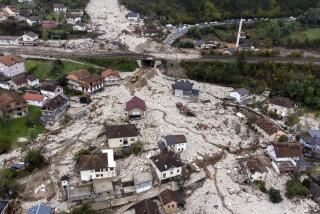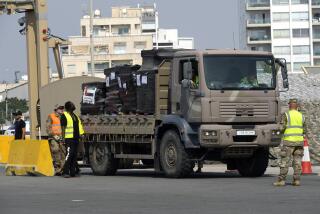Documentary : Bosnia Aid Travels a Gantlet of Fear : The main highway is a target range. So, U.N. convoys take to crude dirt paths, lurching past harrowing obstacles.
- Share via
DOLJANI, Bosnia-Herzegovina — At a hairpin turn along a glorified goat track now deputized as a vital highway, a white trailer van marked with a red cross has bucked loose from its hauler and nose-dived into the mud.
The errant trailer, thrown free after bumping for hours along a path for which motorized vehicles were never intended, will block all further movement on the road for two days and break the last lifeline to Bosnia’s hungry.
As each truck in a lumbering convoy is brought up sharply behind the ill-fated trailer, drivers set their brakes and dismount to join a reverie of recriminations, suggestions and curses.
It’s an event for the entire village--probably the biggest excitement to befall the humble folk of Doljani for the better part of a decade.
The tiny village’s few children have emerged from stone huts to get underfoot. Farmers trussing vineyards for winter stop to watch from the hillsides, rolling cigarettes and leaning on their hoes. Wizened old farm women have halted their early-morning trek to highland pastures to take in the foreign commotion.
Peering out from split-rail fences, even the cows look concerned.
Until the tumbled trailer can be righted and pulled off the path, the dozens of foreign aid trucks that daily ply this “road of life” will have to wait with their vital deliveries or risk a more dangerous route.
Each day, 1,300 tons of food, medicine and blankets are readied for shipment to war-battered Bosnians to fill the voids left by idled industry, untilled fields, bombed hospitals and barricaded supply lines. But shelling and sniping and rival roadblocks frustrate the aid’s passage, forcing relief volunteers to rely on the most primitive back roads.
There is a relatively modern highway running all the way from the Adriatic Sea coast to the capital of Sarajevo, where 400,000 civilians are in desperate need after seven months of siege by Serbian forces.
But guerrillas--opposed to both Bosnian independence and any assistance to the Sarajevo holdouts--have been attacking convoys that dare to use that main route along the Neretva River, which divides the rebel-held east from land under the control of Muslims and Croats.
The highway between Metkovic and Mostar is gouged with shell craters from successive waves of fighting for control of now-shattered riverfront villages. North of Mostar, on the way to Jablanica, the road precariously threads along sheer, towering cliffs, offering the rebel Serbs a bird’s-eye view of the convoys and the high ground from which they can fire with virtual impunity.
One 12-vehicle convoy of the U.N. High Commissioner for Refugees was forced to take cover in a cliff-side tunnel last week when Serbs trapped them there by lobbing mortars at the entrance and exit.
Sarajevo is helped by a U.N.-sponsored airlift that flies about 30 tons of relief goods in daily. But that shuttle is frustrated by persistent fighting around the airport and by fog that closes the staging base at Zagreb, placing the brunt of relief work on convoys that must dodge the worst of the war.
“We’ve got something like a 1,000-mile front line now that is moving all the time,” complains Peter Kessler, spokesman for the UNHCR’s Zagreb headquarters.
To avoid the most hostile venues, the convoys have opted for this rugged route through Doljani, which may be the lesser of several evils on the military front but is not without its trade-offs.
About 20% of the 200-mile route to Sarajevo is across crude dirt roads, which deteriorate to steep, rocky ruts at the highest and most remote stretches.
And when the heavy snows of the Balkan winter dust the already slick and exposed tracts, the overused road between Tomislav Grad and the crucial junction of Jablanica won’t be accessible at all.
Most aid convoys headed for Sarajevo or central Bosnia, where the bulk of those displaced by the war have holed up, set off north from the concrete high-rises and Italian-style villas of the port of Split into the scruffy Dalmatian hills that rise dramatically from the coast. The mild sea breezes and cypress trees disappear abruptly, replaced by craggy rocks bleached white by the summer’s scorching sun.
The winding mountain road to Sinj and Imotski passes through Croatian territory with little ado. Blue-uniformed police at key crossroads stop the vehicles only to check documents.
Once across the border into Bosnia, the atmosphere becomes more charged. Tomislav Grad, though only 15 miles from the Croatian border, is a tense, front-line city echoing with the crashes and shudders of heavy artillery.
Streets are filled with men in camouflage jumpsuits with AK-47s bumping at the hip. Hewn logs have been lashed together and braced against doorways and ground-floor windows to protect them from glass-shattering shrapnel. The echo of an all-clear siren never quite dissipates before the next general alarm wails to warn those in the street to take cover.
A city of 30,000 hosting almost half again as many of Bosnia’s displaced, Tomislav Grad has recently been added as a reception point for the foreign aid.
The convoy that has so far traveled a paved and relatively peopled route now heads southeasterly across Dugo Polje, or Long Field, a grassy plain between purple mountains that evokes images of Wyoming or a spaghetti western set.
But climbing eastward through the scenic mountains, the wide gravel road of the plain swiftly gives way to a narrow track cut into the slopes. The mildest rain poses the risk of a deadly slide and roll into deep ravines. The greatest fear is of an oncoming vehicle and the ordeal of backing up to find a wide spot to pass.
At Doljani, just west of where the trailer of the British aid group Serious Road Trip has fallen off, the locals are pushing a detour. It is essentially a dry creek bed used as a cart and wheelbarrow track by the few dozen villagers eking out a living from this isolated and desolate land.
Only the four-wheel-drive rigs with good clearance and little girth manage to bounce through the heart of the village along the path of rocks, roots and fresh dung steaming in the crisp mountain air. At the depth of the valley is a river to cross, mercifully shallow, then the route heads up a firm hillside to rejoin the dirt road beyond the disabled truck.
Ten miles later, the convoys resume pavement, just before Jablanica, the next stop on their route. Here, as in Tomislav Grad, laundry is strung across schools, barracks and sports halls, the telltale markings of a city inundated with refugees.
Usually, hopefully, the various routes from here are uneventful until drivers run up against front-line checkpoints and soldiers not always pleased that aid and sustenance might reach their enemy. At the most chilling roadblocks, where drunk irregulars wear ski masks and play with machine guns as if they were pencils, vehicle inspections can change from security checks to opportunities for hijacking, extortion or theft.
Dozens of aid trucks have been stolen and countless boxes of goods have been paid out at such checkpoints in exchange for unhindered passage.
When the gunmen’s demands for payoffs siphon off so much of the relief that the trip becomes futile, aid agencies drop that route from their schedule, as has happened in recent weeks with the desperate city of Tuzla, now completely cut off by Serbs.
A U.N. peacekeeping operation is being beefed up to help the convoys break through such obstructive blockades. But the additional 6,000 foreign troops assigned to escort aid to Bosnia’s beleaguered will not be fully deployed until December, by which time the current route will likely have been closed by heavy snow.
“We’re in a race against the clock. They (Serbian rebels) want to get all the main roads locked up so they can dig themselves in for the winter, and we want to keep them open so we can continue to feed people,” said a refugee relief worker in the central Bosnian city of Vitez, voicing fear that the worsening weather could soon cut off all aid delivered by land.
“We need to build up buffer stocks, but instead we’re getting less and less in,” the European lamented. “People can get by on fewer calories when it’s warm outside, but they’ll freeze to death if they go hungry in this weather.”
More to Read
Sign up for Essential California
The most important California stories and recommendations in your inbox every morning.
You may occasionally receive promotional content from the Los Angeles Times.











